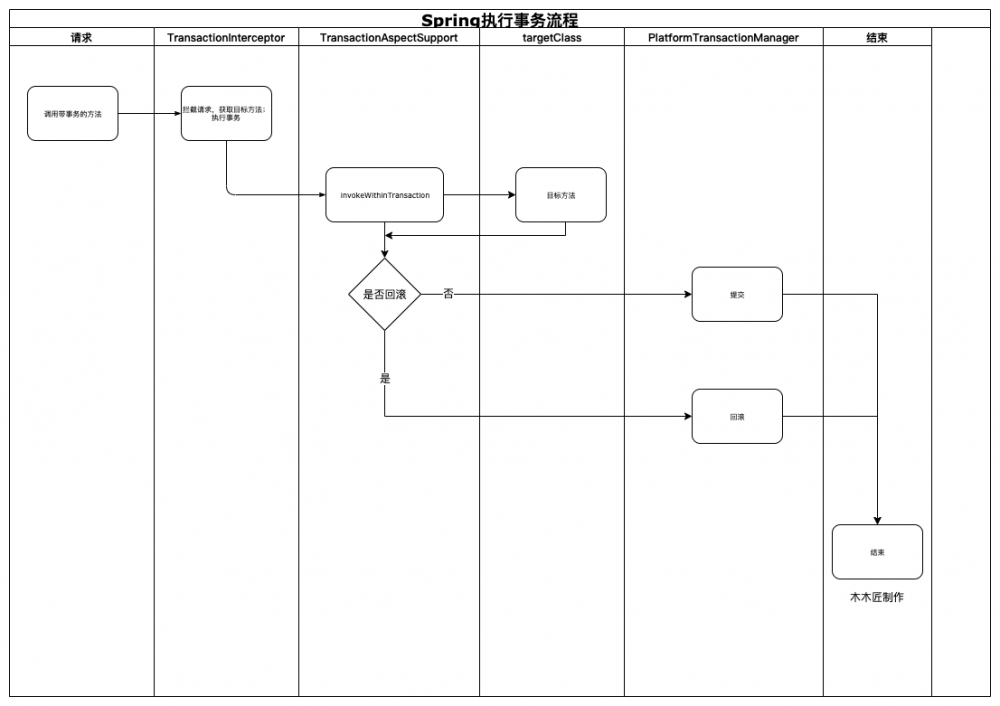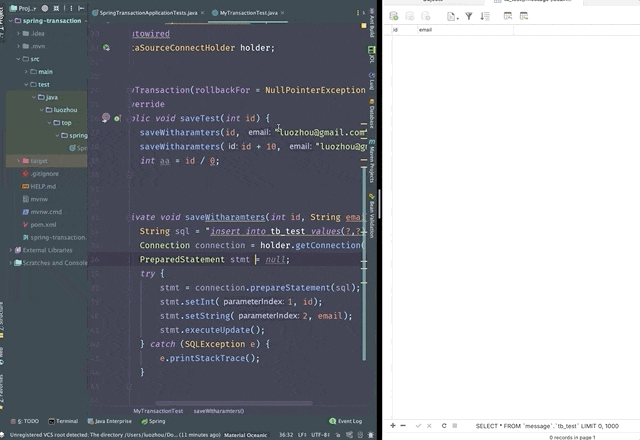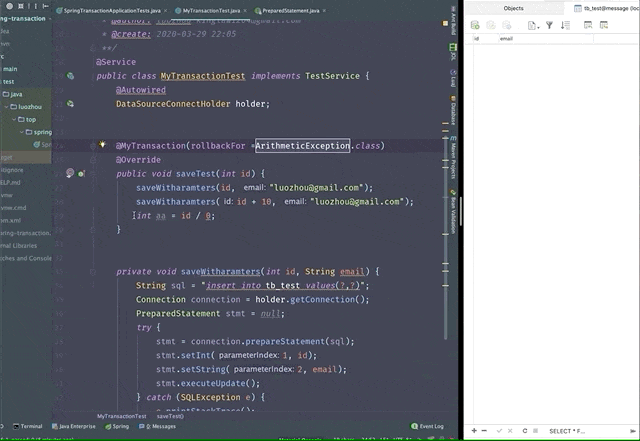自己亲手写一个SpringBoot的事物
1. 概述
一直在用SpringBoot中的 @Transactional 来做事务管理,但是很少没想过SpringBoot是如何实现事务管理的,今天从源码入手,看看 @Transactional 是如何实现事务的,最后我们结合源码的理解,自己动手写一个类似的注解来实现事务管理,帮助我们加深理解。
阅读说明:本文假设你具备Java基础,同时对事务有基本的了解和使用。
2. 事务的相关知识
开始看源码之前,我们先回顾下事务的相关知识。
2.1 事务的隔离级别
事务为什么需要隔离级别呢?这是因为在并发事务情况下,如果没有隔离级别会导致如下问题:
- 脏读(Dirty Read) :当A事务对数据进行修改,但是这种修改还没有提交到数据库中,B事务同时在访问这个数据,由于没有隔离,B获取的数据有可能被A事务回滚,这就导致了数据不一致的问题。
- 丢失修改(Lost To Modify) : 当A事务访问数据100,并且修改为100-1=99,同时B事务读取数据也是100,修改数据100-1=99,最终两个事务的修改结果为99,但是实际是98。事务A修改的数据被丢失了。
- 不可重复读(Unrepeatable Read) :指A事务在读取数据X=100的时候,B事务把数据X=100修改为X=200,这个时候A事务第二次读取数据X的时候,发现X=200了,导致了在整个A事务期间,两次读取数据X不一致了,这就是不可重复读。
- 幻读(Phantom Read) :幻读和不可重复读类似。幻读表现在,当A事务读取表数据时候,只有3条数据,这个时候B事务插入了2条数据,当A事务再次读取的时候,发现有5条记录了,平白无故多了2条记录,就像幻觉一样。
不可重复读 VS 幻读
不可重复读的重点是修改 : 同样的条件 , 你读取过的数据 , 再次读取出来发现值不一样了,重点在更新操作。 幻读的重点在于新增或者删除 :同样的条件 , 第 1 次和第 2 次读出来的记录数不一样,重点在增删操作。
所以,为了避免上述的问题,事务中就有了隔离级别的概念,在Spring中定义了五种表示隔离级别的常量:
常量说明TransactionDefinition.ISOLATION_DEFAULT数据库默认的隔离级别,MySQL默认采用的 REPEATABLE_READ隔离级别TransactionDefinition.ISOLATION_READ_UNCOMMITTED最低的隔离级别,允许读取未提交的数据变更, 可能会导致脏读、幻读或不可重复读 。TransactionDefinition.ISOLATION_READ_COMMITTED允许读取并发事务已经提交的数据, 可以阻止脏读,但是幻读或不可重复读仍有可能发生 。TransactionDefinition.ISOLATION_REPEATABLE_READ对同一字段的多次读取结果都是一致的,除非数据是被本身事务自己所修改,**可以阻止脏读和不可重复读,但幻读仍有可能发生。**MySQL中通过MVCC解决了该隔离级别下出现幻读的可能。TransactionDefinition.ISOLATION_SERIALIZABLE串行化隔离级别, 该级别可以防止脏读、不可重复读以及幻读 ,但是串行化会影响性能。
2.2 Spring中事务的传播机制
为什么Spring中要搞一套事务的传播机制呢?这是Spring给我们提供的事务增强工具,主要是解决方法之间调用,事务如何处理的问题。比如有方法A、方法B和方法C,在A中调用了方法B和方法C。伪代码如下:
MethodA{
MethodB;
MethodC;
}
MethodB{
}
MethodC{
}
假设三个方法中都开启了自己的事务,那么他们之间是什么关系呢? MethodA 的回滚会影响 MethodB 和 MethodC 吗?Spring中的事务传播机制就是解决这个问题的。
Spring中定义了七种事务传播行为:
类型说明PROPAGATION_REQUIRED如果当前没有事务,就新建一个事务,如果已经存在一个事务中,加入到这个事务中。这是最常见的选择PROPAGATION_SUPPORTS支持当前事务,如果当前没有事务,就以非事务方式执行。PROPAGATION_MANDATORY使用当前的事务,如果当前没有事务,就抛出异常。PROPAGATION_REQUIRES_NEW新建事务,如果当前存在事务,把当前事务挂起。PROPAGATION_NOT_SUPPORTED以非事务方式执行操作,如果当前存在事务,就把当前事务挂起。PROPAGATION_NEVER以非事务方式执行,如果当前存在事务,则抛出异常。PROPAGATION_NESTED如果当前存在事务,则在嵌套事务内执行。如果当前没有事务,则执行与PROPAGATION_REQUIRED类似的操作。
这七种传播机制是如何影响事务的,感兴趣的同学可以阅读 这篇文章 。
3. 如何实现异常回滚的
回顾完了事务的相关知识,接下来我们正式来研究下Spring Boot中如何通过 @Transactional 来管理事务的,我们重点看看它是如何实现回滚的。
在Spring中 TransactionInterceptor 和 PlatformTransactionManager 这两个类是整个事务模块的核心, TransactionInterceptor 负责拦截方法执行,进行判断是否需要提交或者回滚事务。 PlatformTransactionManager 是Spring 中的事务管理接口,真正定义了事务如何回滚和提交。我们重点研究下这两个类的源码。
TransactionInterceptor 类中的代码有很多,我简化一下逻辑,方便说明:
//以下代码省略部分内容
public Object invoke(MethodInvocation invocation) throws Throwable {
//获取事务调用的目标方法
Class<?> targetClass = (invocation.getThis() != null ? AopUtils.getTargetClass(invocation.getThis()) : null);
//执行带事务调用
return invokeWithinTransaction(invocation.getMethod(), targetClass, invocation::proceed);
}
invokeWithinTransaction 简化逻辑如下:
//TransactionAspectSupport.class
//省略了部分代码
protected Object invokeWithinTransaction(Method method, @Nullable Class<?> targetClass,
final InvocationCallback invocation) throws Throwable {
Object retVal;
try {
//调用真正的方法体
retVal = invocation.proceedWithInvocation();
}
catch (Throwable ex) {
// 如果出现异常,执行事务异常处理
completeTransactionAfterThrowing(txInfo, ex);
throw ex;
}
finally {
//最后做一下清理工作,主要是缓存和状态等
cleanupTransactionInfo(txInfo);
}
//如果没有异常,直接提交事务。
commitTransactionAfterReturning(txInfo);
return retVal;
}
事务出现异常回滚的逻辑 completeTransactionAfterThrowing 如下:
//省略部分代码
protected void completeTransactionAfterThrowing(@Nullable TransactionInfo txInfo, Throwable ex) {
//判断是否需要回滚,判断的逻辑就是看有没有声明事务属性,同时判断是不是在目前的这个异常中执行回滚。
if (txInfo.transactionAttribute != null && txInfo.transactionAttribute.rollbackOn(ex)) {
//执行回滚
txInfo.getTransactionManager().rollback(txInfo.getTransactionStatus());
}
else {
//否则不需要回滚,直接提交即可。
txInfo.getTransactionManager().commit(txInfo.getTransactionStatus());
}
}
}
上面的代码已经把Spring的事务的基本原理说清楚了,如何进行判断执行事务,如何回滚。下面到了真正执行回滚逻辑的代码中 PlatformTransactionManager 接口的子类,我们以JDBC的事务为例, DataSourceTransactionManager 就是jdbc的事务管理类。跟踪上面的代码 rollback(txInfo.getTransactionStatus()) 可以发现最终执行的代码如下:
@Override
protected void doRollback(DefaultTransactionStatus status) {
DataSourceTransactionObject txObject = (DataSourceTransactionObject) status.getTransaction();
Connection con = txObject.getConnectionHolder().getConnection();
if (status.isDebug()) {
logger.debug("Rolling back JDBC transaction on Connection [" + con + "]");
}
try {
//调用jdbc的 rollback进行回滚事务。
con.rollback();
}
catch (SQLException ex) {
throw new TransactionSystemException("Could not roll back JDBC transaction", ex);
}
}
3.1 小结
这里小结下Spring 中事务的实现思路,Spring 主要依靠 TransactionInterceptor 来拦截执行方法体,判断是否开启事务,然后执行事务方法体,方法体中 catch 住异常,接着判断是否需要回滚,如果需要回滚就委托真正的 TransactionManager 比如JDBC中的 DataSourceTransactionManager 来执行回滚逻辑。提交事务也是同样的道理。
这里用个流程图展示下思路:

4. 手写一个注解实现事务回滚
我们弄清楚了Spring的事务执行流程,那我们可以模仿着自己写一个注解,实现遇到指定异常就回滚的功能。这里持久层就以最简单的JDBC为例。我们先梳理下需求,首先注解我们可以基于Spring 的AOP来实现,接着既然是JDBC,那么我们需要一个类来帮我们管理连接,用来判断异常是否回滚或者提交。梳理完就开干吧。
4.1 首先加入依赖
<dependency>
<groupId>org.springframework.boot</groupId>
<artifactId>spring-boot-starter-jdbc</artifactId>
</dependency>
<dependency>
<groupId>org.springframework.boot</groupId>
<artifactId>spring-boot-starter-aop</artifactId>
</dependency>
4.2 新增一个注解
/**
* @description:
* @author: luozhou
* @create: 2020-03-29 17:05
**/
@Target({ElementType.METHOD})
@Retention(RetentionPolicy.RUNTIME)
@Inherited
@Documented
public @interface MyTransaction {
//指定异常回滚
Class<? extends Throwable>[] rollbackFor() default {};
}
4.3 新增连接管理器
该类帮助我们管理连接,该类的核心功能是把取出的连接对象绑定到线程上,方便在AOP处理中取出,进行提交或者回滚操作。
/**
* @description:
* @author: luozhou
* @create: 2020-03-29 21:14
**/
@Component
public class DataSourceConnectHolder {
@Autowired
DataSource dataSource;
/**
* 线程绑定对象
*/
ThreadLocal<Connection> resources = new NamedThreadLocal<>("Transactional resources");
public Connection getConnection() {
Connection con = resources.get();
if (con != null) {
return con;
}
try {
con = dataSource.getConnection();
//为了体现事务,全部设置为手动提交事务
con.setAutoCommit(false);
} catch (SQLException e) {
e.printStackTrace();
}
resources.set(con);
return con;
}
public void cleanHolder() {
Connection con = resources.get();
if (con != null) {
try {
con.close();
} catch (SQLException e) {
e.printStackTrace();
}
}
resources.remove();
}
}
4.4 新增一个切面
这部分是事务处理的核心,先获取注解上的异常类,然后捕获住执行的异常,判断异常是不是注解上的异常或者其子类,如果是就回滚,否则就提交。
/**
* @description:
* @author: luozhou
* @create: 2020-03-29 17:08
**/
@Aspect
@Component
public class MyTransactionAopHandler {
@Autowired
DataSourceConnectHolder connectHolder;
Class<? extends Throwable>[] es;
//拦截所有MyTransaction注解的方法
@org.aspectj.lang.annotation.Pointcut("@annotation(luozhou.top.annotion.MyTransaction)")
public void Transaction() {
}
@Around("Transaction()")
public Object TransactionProceed(ProceedingJoinPoint proceed) throws Throwable {
Object result = null;
Signature signature = proceed.getSignature();
MethodSignature methodSignature = (MethodSignature) signature;
Method method = methodSignature.getMethod();
if (method == null) {
return result;
}
MyTransaction transaction = method.getAnnotation(MyTransaction.class);
if (transaction != null) {
es = transaction.rollbackFor();
}
try {
result = proceed.proceed();
} catch (Throwable throwable) {
//异常处理
completeTransactionAfterThrowing(throwable);
throw throwable;
}
//直接提交
doCommit();
return result;
}
/**
* 执行回滚,最后关闭连接和清理线程绑定
*/
private void doRollBack() {
try {
connectHolder.getConnection().rollback();
} catch (SQLException e) {
e.printStackTrace();
} finally {
connectHolder.cleanHolder();
}
}
/**
*执行提交,最后关闭连接和清理线程绑定
*/
private void doCommit() {
try {
connectHolder.getConnection().commit();
} catch (SQLException e) {
e.printStackTrace();
} finally {
connectHolder.cleanHolder();
}
}
/**
*异常处理,捕获的异常是目标异常或者其子类,就进行回滚,否则就提交事务。
*/
private void completeTransactionAfterThrowing(Throwable throwable) {
if (es != null && es.length > 0) {
for (Class<? extends Throwable> e : es) {
if (e.isAssignableFrom(throwable.getClass())) {
doRollBack();
}
}
}
doCommit();
}
}
4.5 测试验证
创建一个tb_test表,表结构如下:
SET NAMES utf8mb4; SET FOREIGN_KEY_CHECKS = 0; -- ---------------------------- -- Table structure for tb_test -- ---------------------------- DROP TABLE IF EXISTS `tb_test`; CREATE TABLE `tb_test` ( `id` int(11) NOT NULL, `email` varchar(255) DEFAULT NULL, PRIMARY KEY (`id`) ) ENGINE=InnoDB DEFAULT CHARSET=latin1; SET FOREIGN_KEY_CHECKS = 1;
4.5.1 编写一个Service
saveTest 方法调用了2个插入语句,同时声明了 @MyTransaction 事务注解,遇到 NullPointerException 就进行回滚,最后我们执行了除以0操作,会抛出 ArithmeticException 。我们用单元测试看看数据是否会回滚。
/**
* @description:
* @author: luozhou kinglaw1204@gmail.com
* @create: 2020-03-29 22:05
**/
@Service
public class MyTransactionTest implements TestService {
@Autowired
DataSourceConnectHolder holder;
//一个事务中执行两个sql插入
@MyTransaction(rollbackFor = NullPointerException.class)
@Override
public void saveTest(int id) {
saveWitharamters(id, "luozhou@gmail.com");
saveWitharamters(id + 10, "luozhou@gmail.com");
int aa = id / 0;
}
//执行sql
private void saveWitharamters(int id, String email) {
String sql = "insert into tb_test values(?,?)";
Connection connection = holder.getConnection();
PreparedStatement stmt = null;
try {
stmt = connection.prepareStatement(sql);
stmt.setInt(1, id);
stmt.setString(2, email);
stmt.executeUpdate();
} catch (SQLException e) {
e.printStackTrace();
}
}
}
4.5.2 单元测试
@SpringBootTest
@RunWith(SpringRunner.class)
class SpringTransactionApplicationTests {
@Autowired
private TestService service;
@Test
void contextLoads() throws SQLException {
service.saveTest(1);
}
}

上图代码声明了事务对 NullPointerException 异常进行回滚,运行中遇到了 ArithmeticException 异常,所以是不会回滚的,我们在右边的数据库中刷新发现数据正常插入成功了,说明并没有回滚。

我们把回滚的异常类改为 ArithmeticException ,把原数据清空再执行一次,出现了 ArithmeticException 异常,这个时候查看数据库是没有记录新增成功了,这说明事物进行回滚了,表明我们的注解起作用了。
5. 总结
本文最开始回顾了事务的相关知识,并发事务会导致 脏读 、 丢失修改 、 不可重复读 、 幻读 ,为了解决这些问题,数据库中就引入了事务的隔离级别,隔离级别包括: 读未提交 、 读提交 、 可重复读 和 串行化 。
Spring中增强了事务的概念,为了解决方法A、方法B和方法C之间的事务关系,引入了事务传播机制的概念。
Spring中的 @Transactional 注解的事务实现主要通过 TransactionInterceptor 拦截器来进行实现的,拦截目标方法,然后判断异常是不是目标异常,如果是目标异常就行进行回滚,否则就进行事务提交。
最后我们自己通过JDBC结合Spring的AOP自己写了个 @MyTransactional 的注解,实现了遇到指定异常回滚的功能。
参考地址
- https://juejin.im/post/5e7ef0bae51d4546f16bb3fb
如果大家喜欢我的文章,可以关注个人订阅号。欢迎随时留言、交流。如果想加入微信群的话一起讨论的话,请加管理员简栈文化-小助手(lastpass4u),他会拉你们进群。

- 本文标签: 数据库 AOP 代码 zab spring 总结 struct autocommit UI bug key 源码 src description IO 管理 缓存 mysql final ip 文章 sql springboot Document 测试 Connection tar ORM NSA Statement 解决方法 mail ACE cat Spring Boot App 并发 update dataSource Service IDE JDBC REST db 删除 线程 id 需求 单元测试 java java基础 https Action 数据 传播行为 value tab http
- 版权声明: 本文为互联网转载文章,出处已在文章中说明(部分除外)。如果侵权,请联系本站长删除,谢谢。
- 本文海报: 生成海报一 生成海报二










![[HBLOG]公众号](https://www.liuhaihua.cn/img/qrcode_gzh.jpg)

